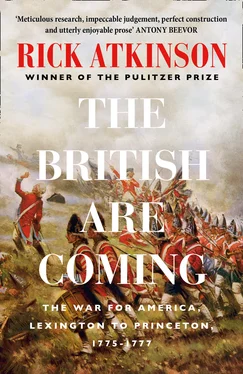Gage chose a more conventional, direct assault to be led by Howe, the senior major general. As in the march to Concord, most flanker companies—light infantry and grenadiers—had been peeled from their regiments and collected in special battalions. Ten companies of each would muster at Long Wharf, bolstered by several other regiments. The remaining light infantry and grenadiers, backed by additional regiments, would embark at North Battery, with sundry marines and regulars in reserve.
Gage ended the conference with a stark order: “Any man who shall quit his ranks on any pretense, or shall dare to plunder or pillage, will be executed without mercy.” With a clatter of boots across the floor, officers hurried down the hall and out the door to prepare their commands for battle.
Admiral Graves, meanwhile, had left his flagship to board the seventy-gun Somerset , now anchored in deep water across Boston Harbor. From her gently rocking quarterdeck he could see rebels swarming across the Charlestown hillside around the new earthworks; many were already “entrenched to their chins,” as a British officer noted. Men-of-war belched smoke and noise, and tiny black cannonballs traced perfect parabolas against the summer sky, plumping the fields and splintering tree branches without excessive inconvenience to the Jonathans building their forts. To Graves’s frustration, the waters lapping Charlestown were too shallow for Somerset and other dreadnoughts to warp close; his larger ships would be limited to sending seamen, ammunition, and boats to their smaller sisters.
As the morning ticked by, Glasgow and Symmetry hammered Charlestown Neck from an anchorage west of the peninsula, supported by a pair of scows, each mounting a 12-pounder. But the ebbing tide kept them from nosing near the milldam, and Graves regretted his failure to build more floating batteries and gun rafts. Lively , Falcon , and little Spitfire glided into the Charlestown channel, popping away while preparing to cover Howe’s landing. The roar of the cannonade carried to Cambridge, Roxbury, and other villages; one terrified minister’s wife draped blankets over her windows in hopes of deflecting stray bullets.
Shortly before noon, as meridian heat began to build in Boston, long columns of regulars tramped to fife and drum through the town’s cobbled streets from the Common to the docks. Each man carried, as ordered, sixty rounds, a day’s cooked provisions, and a blanket. The 52nd Foot had been issued gleaming new muskets and bayonets that very morning; they would soon grow filthy with use. By chance, a portion of the 49th Foot had just arrived after a long passage from southern Ireland. Wide-eyed privates, wobbly on their pins after weeks at sea, disembarked on Long Wharf and marched toward the Common with flags flying and drums beating even as the grenadier and light infantry companies from other regiments clambered into the bobbing boats at Long Wharf for the first lift to Charlestown.
At one-thirty p.m., a blue pennant appeared on Preston ’s signal halyard. Twenty-eight yawls, longboats, cutters, and ketches carrying twelve hundred soldiers pulled away from Long Wharf in a double column, oars winking in syncopation, with a half dozen brass field guns nestled into the lead boats. The cannonade from the ships had ebbed, but now it grew heavier than ever, balls flying, smoke billowing, and the din reverberating like a terrible thunder. Thousands crowded Boston’s rooftops and hillsides, perching on tree boughs and clinging to steeples. Among the spectators were regulars left behind and the wives of troops now gliding across the Charles. Loyalists and patriots stood together, aware that sons and fathers and lovers were down there somewhere in harm’s way, on the glinting water or the distant hillside.
Here again was an ancient, squalid secret: that war was an enchantment, a sorcery, a seductive spectacle like no other, beguiling the eye and gorging the senses. They looked because they could not look away. Atop Bunker Hill, a Connecticut chaplain named David Avery watched the sculling boats approach Morton’s Point, then raised both arms to heaven before asking God’s indulgence on “a scene most awful and tremendous.”
Astride a lathered white horse, his own halo of tangled white hair instantly recognizable, General Israel Putnam trotted back and forth across the American line in a sleeveless waistcoat, smacking shirkers with the flat of his sword. To an officer pleading with a reluctant militiaman, Putnam snapped, “Run him through if he won’t fight.” One captain would later reflect that Old Put resembled not a field commander so much as the foreman of “a band of sicklemen or ditchers.… He might be brave, and had certainly an honest manliness about him; but it was thought, and perhaps with reason, that he was not what the time required.”
Nine Massachusetts regiments had been ordered to Charlestown from Cambridge, but at best only five had reached the peninsula; the others were delayed, misdirected, or misinformed. No one seemed to have a map. Roads were confusing, the terrain foreign. Troop discipline was “extremely irregular,” one officer wrote, “each regiment advancing according to the opinions, feelings, or caprice of its commander.” Putnam had ordered entrenching tools carried back from the redoubt to belatedly build a fortification on Bunker Hill; eager volunteers grabbed a shovel or an ax, then retreated toward the Neck and beyond, never to return. By one count, fewer than 170 men remained with Prescott to hold his redoubt, officers included. “To be plain,” an observer would write Samuel Adams, “it appears to me there never was more confusion and less command.”
Happily for the American cause, some men knew their business. Colonel Prescott continued to improve his imperfect fort and the adjacent breastwork, positioning men and shouting encouragement. Roughly two hundred yards behind the breastwork, a tall, enterprising captain from eastern Connecticut, Thomas Knowlton, recognized the defensive potential of a rail livestock fence that extended northeast for several hundred yards, from the middle of the peninsula almost to the Mystic. The fence had been laid on a slight zigzag course and assembled with a method known as stake-and-rider; a portion of it straddled a two-foot stone wall. Two hundred men helped Captain Knowlton reinforce the southwestern length of the barrier with additional rails and posts scavenged from other fields. They then stuffed the gaps with haycocks and sheaves of cut grass to give the illusion of a solid parapet. Several small field guns hauled by horses from Cambridge were emplaced nearby.
As the British boats beat from Boston, the most critical rebel reinforcements reached Charlestown Neck to the thrum of fife and drum: hundreds of long-striding New Hampshire militiamen, described as a “moving column of uncouth figures clad in homespun.” Millers, mariners, and husbandmen, they included the largest regiment in New England, commanded by Colonel John Stark, the lean, beetle-browed son of a Scottish emigrant. Stark’s picaresque life had included capture by Indians while hunting in 1752 and his release six weeks later for a hefty ransom. As a Ranger officer in the last French war, he had plodded more than forty miles in snowshoes to fetch help for comrades wounded in an ambush. After surviving the bloody Anglo-American repulse by the French at Fort Carillon in 1758, he and two hundred men subsequently built an eighty-mile road from Crown Point to the Connecticut valley. Upon hearing the news of Lexington, Stark, now forty-six, left his sawmill and his wife, pregnant with their ninth child, and was elected colonel by a unanimous show of hands in a tavern; so many men rallied to him that thirteen companies filled his regiment. At eleven this morning, General Ward’s initial order to reinforce Charlestown reached Stark’s camp in Medford, four miles up the Mystic. As he would tell the New Hampshire Provincial Congress a few days later, “The battle soon came on.”
Читать дальше












